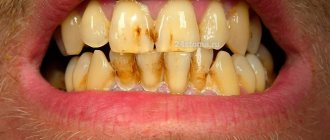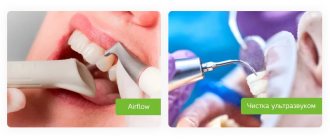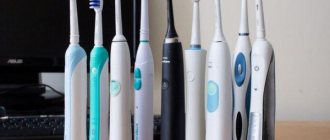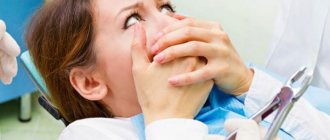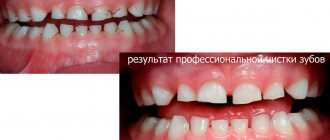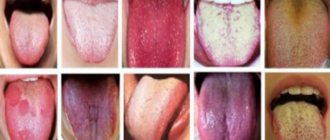Publication date: 01/22/2021
The expression “snow-white smile” has firmly entered our everyday life. It is the white color of teeth that we associate with their health. In fact, the natural color of a tooth is slightly yellowish. Minerals give this shade to teeth. The more minerals, the stronger the tooth. The appearance of white spots indicates that demineralization of the enamel has begun. But sometimes the pigmentation of teeth gets out of control and then the yellowish natural tint turns into a yellow plaque.
Plaque occurs in all people; it is a natural process. There are many bacteria living in the oral cavity of every person. Brushing your teeth does not help get rid of them, no matter how thorough it is. A transparent organic film - pellicle
.Bacteria quickly accumulate on its surface and dental plaque forms. Sometimes dentists use a colored solution to show where bacteria is most concentrated. It is the pellicle that is colored dark. In the same way, the pellicle is colored under the influence of many substances: food pigments, drugs, resins and tar. The problem starts with a small spot, but over time the layers accumulate and the teeth acquire an unpleasant yellow or even brown tint.
What reasons contribute to the appearance of plaque?
- Smoking Tar and tar contained in cigarettes settle on the surface, changing the color of the enamel over time.
- Drinking drinks whose color is due to strong dyes. Coffee, tea, sweet soda, and red wine promote pigmentation. At the same time, soda also harms teeth, contributing to the occurrence of caries.
- Pigmented berries Blueberries, blueberries, black currants, all dark berries are rich in pigments that settle on the teeth.
- Some medications Particularly famous for this are drugs from the tetracycline group.
- Irregular and ineffective oral hygiene Yes, we all brush our teeth twice a day, but for how long and how thoroughly?
- Lack of solid foods in the diet Carrots and apples, other solid vegetables and fruits naturally clean teeth. Soft food does not clean teeth; on the contrary, it tends to accumulate in all the crevices. This promotes plaque formation.
- Age-related changes Plaque does not always indicate poor care. With age, the thickness of yellow plaque increases, despite compliance with hygiene rules.
The reasons for the appearance of plaque in a child are the same as in adults. The only exception is that children's teeth may turn yellow if the mother took tetracyclines during pregnancy.
Methods to combat plaque
At the initial stage, soft deposits can be easily removed with a regular toothbrush. Experts also recommend using special rinses, pastes containing useful minerals and additives to strengthen the enamel. If you neglect the recommendations of specialists and forget to brush your teeth, the plaque can become hard. Then it will be much more difficult to deal with him.
Professional cleaning at a dental clinic will help remove stone and other deposits. The examination may also reveal the following pathologies: caries, stomatitis, periodontitis, gingivitis, etc. They will need to be treated first.
An equally popular procedure is enamel whitening. Today there are many methods; the appropriate option should be selected based on the results of a preliminary examination and the clinical picture of a particular patient. Most methods are based on the action of hydrogen peroxide, which, by interacting with a catalyst, breaks down plaque and returns the smile to its former attractiveness. It is important to note that bleaching allows you to lighten enamel up to 14 tones in one session, and professional cleaning only returns the enamel to its original shade.
previous post
Why install dentures where there are no teeth?
next entry
Yellow teeth - how to get rid of them
The Internet is full of tips on how to get rid of yellow plaque yourself.
The most popular recommendation is to use soda slurry. The method is quite aggressive, it can be used no more than once a week.
Get rid of plaque yourself
The best way to get rid of plaque on your own is to use whitening paste, whitening strips, and special gels. They are used in courses, with a break between them.
Activated carbon, lemon juice, hydrogen peroxide - when using these products, the harm may outweigh the whitening effect. In-office whitening is the most preferred option.
Recommendations from Dr. Zubastik
A snow-white smile is attractive and fashionable. If your teeth have acquired a yellowish tint, try one of the suggested remedies. As a doctor, I still recommend pharmacy methods, not home recipes. And don’t forget about the main condition: before whitening, make sure that the oral cavity is sanitized.
And now, as is tradition, video tips on how to overcome yellow teeth. Let's see?
Tags: activated carbon, Vodka, Gel, Yellow teeth, Yellow plaque, Mouth guards, strawberries, lemon, folk remedies, Whitening strips, hydrogen peroxide, soda, Table vinegar, Sage
About the author: Dr. Zubastik
Typically, a toothache begins to subside on the way to the clinic and finally goes away after 10 minutes of sitting in line to see the dentist.
- Related Posts
- A tooth hurts under a temporary filling: what to do?
- Tartar in humans: harm, causes and removal at home
- Why caries is dangerous: all the consequences for the body
« Previous entry
Get rid of plaque in the clinic
In dentistry, methods of direct whitening and plaque cleaning are used, which lightens teeth by 2-3 tones as a “bonus”. The choice of method depends on the severity of the plaque, the final goals, and the general condition of the body.
Get rid of plaque using cleaning methods
- Ultrasonic teeth cleaning
Ultrasound waves are transmitted through a special attachment, removing plaque from teeth and gum pockets. The procedure not only cleanses the teeth, but serves as a prevention of inflammatory periodontal diseases.
- AirFlow
A mixture of air, water and abrasive powder effectively removes plaque.
- Laser cleaning
This is the safest, most effective and expensive procedure. The laser not only removes plaque, it stimulates blood flow in the gums and relieves inflammation.
Whitening
- Photon This external procedure allows you to change the shade by 7-9 tones. A special composition is applied to the teeth, from which oxygen is released under the influence of light. It penetrates dentin and breaks down coloring pigments.
- Intra-canal bleaching If the tooth has darkened due to the use of medications, or during depulpation, a bleaching agent is placed directly into the cavity, followed by filling.
What causes enamel color change
There are many factors due to which teeth gradually lose their natural whiteness. Enamel is very sensitive to the effects of dyes, so frequent consumption of products such as black tea, natural berry juices or beets leads to its darkening. In addition, the outer surface of the teeth is not spared and our harmful addictions, for example, to smoking or drinking wine.
Of course, the main reason for darkening of the enamel is insufficient hygiene. In addition, plaque can accumulate due to wearing orthodontic structures - braces, as they make cleaning with a brush difficult. It is also important to know about the dangers of some tetracycline antibacterial drugs.
Another provoking factor is the progression of various diseases of the digestive tract. In any case, if you notice severe deposits on the surface of the enamel, it is recommended to go to the dental clinic for a consultation as soon as possible. An experienced doctor will help you choose the right treatment and prevent the development of complications.
Online consultation with a doctor if you are concerned about symptoms
Alternative Methods
Sometimes the use of whitening procedures is contraindicated or the patient simply does not want to do it on a regular basis. In such cases, overlays are used.
- Veneers
Special veneers are made from ceramic or composite materials. They are selected to match the size of the teeth and then glued to the outer surface. Veneers are made in small rows of 5-7 pieces. Teeth under veneers, unlike crowns, remain alive. And they can be changed every 10-15 years.
- Lumineers
These linings are made from special porcelain, reinforced with nickel for strength. They are thinner than veneers, and teeth do not have to be specially prepared for them.
Dental veneers don't just change color, they rejuvenate your smile and strengthen your teeth.
Why is dental plaque dangerous?
Soft and hard deposits seem harmless at first glance. They lead to serious problems such as:
- formation of stone on the outer and inner surfaces of the teeth, in the interdental spaces;
- inflammatory processes of mucous membranes, including gums;
- bad breath that does not go away even after rinsing and brushing;
- disruptions in the gastrointestinal tract.
Anything that accumulates on the enamel must be removed in a timely manner. Otherwise, negative consequences cannot be avoided.
Prevention
Simple measures will help you avoid or at least delay the appearance of yellow spots on your teeth:
- Choosing the right brush A brush that is too soft does not remove plaque, and a brush that is too hard can damage the enamel.
- Remember about dental floss Where there are bacteria, there is plaque. And bacteria love spaces where the brush cannot reach. Floss will remove food debris, decay products, and reduce the possibility of bacterial flora reproducing.
- We buy paste according to the task. Whitening, therapeutic, preventive - you should not be thoughtless when choosing toothpastes. In cases of medicated paste, it is better to consult a doctor before making a purchase.
- We drink and clean, we clean and drink. Is it not easy to give up a cup of coffee in the morning and fruit drink on a hot day? Just make it a habit to brush your teeth every time after eating pigmented foods.
- Difficult, but necessary Quitting smoking is the only way to avoid being a smoker.
Why do teeth turn yellow?
It all starts with a small raid. After eating or drinking, a thin film – pellicle – settles on the enamel. Bacteria begin to multiply on its surface, forming plaque. No brush can remove it completely. A dental plaque is formed, which tends to become stained under the influence of pigments, drugs, and resins.
Alas, plaque is not the only cause of yellowness, there are others:
- Genetics
Each person has their own shade of enamel. It is laid down at conception and a special gene is responsible for this. There are congenital diseases that are accompanied by enamel defects (amologenesis, marble disease). Dark shade can be inherited from nature, just like eye color or nose shape.
- Food
Through pores in the enamel, pigments from food penetrate into the dentin, changing its color. In the first place is coffee, black tea, dark berries, red wine. However, there are products whose ability to stain dentin we do not even suspect. Green tea, for example, or vegetables containing carotene: carrots, tomatoes, spinach. Water can have a yellow tint if it contains too much fluoride.
- Medicines and filling materials
Some antibiotics, the most famous of which is tetracycline, can change the color of teeth.
It also changes when using filling material, amalgam.
. Pigments from it can spread throughout the entire crown.
- Age
From the moment the first one erupts, we put our teeth to the test. We eat hot and cold, sour, drink sweet soda, crack seeds, smoke. It's no surprise that the older we get, the more likely we are to develop yellow stains on our teeth. In addition, the thickness of plaque increases over the years, changing the color of the enamel. Teeth become yellower.
- Smoking
Cigarettes contain tar and tar. They settle on the enamel, giving it a yellow-brown tint that begins to accumulate between the teeth and then spreads to the entire surface.
- Oral hygiene
If you do not take care of your teeth, forgetting about regular brushing or flossing, their color will quickly cease to please you. It is worth remembering that professional cleaning is the best way to remove plaque. It should be carried out at least once a year.
It is necessary to care not only for permanent teeth, but also for milk teeth. This needs to be done especially carefully if you have braces installed.
- Location
It happens that fangs look yellower than other teeth. This is the norm. The thickness of the enamel is the same everywhere, but the thickness of the dentin on the fangs is much greater. Therefore, the shade of the fangs is yellowish, even if the rest of the teeth are white.
- Lesions of hard tissues
With a wedge-shaped defect, the teeth turn yellow near the gums, exposing the neck. With fluorosis, yellow spots are located over the entire surface. If a yellow tint appears and it darkens over time, this is a reason to consult a doctor.
Indications and contraindications for whitening
Your teeth should have a fairly strong and thick layer of enamel. Only a dentist can determine its condition. The yellow coating should be superficial. If it is deep, then teeth whitening methods will not bring you the desired result.
Contraindications:
- Increased sensitivity of teeth;
- Allergy to hydrogen peroxide;
- Caries;
- Damage to enamel.
So, if the dentist has determined that there are no contraindications to the procedure, you can perform home teeth whitening, saving time and money, but always proceed from the principle of “do no harm.”
